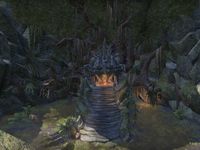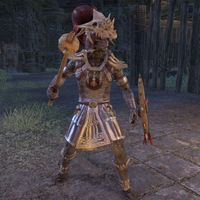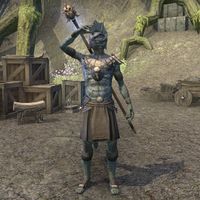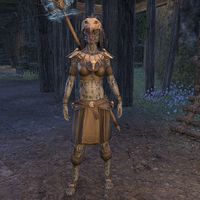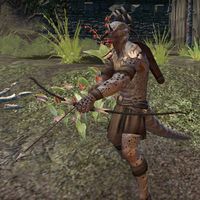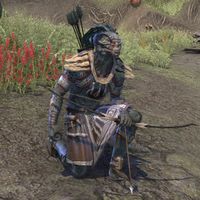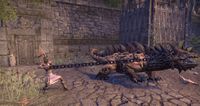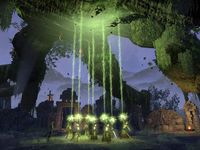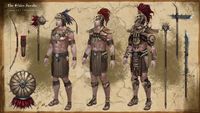Lore:Xit-Xaht
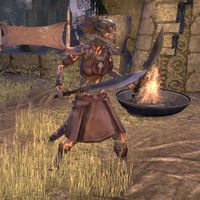
The Xit-Xaht Tribe was an Argonian tribe that historically lived in the city of Mazzatun, located in the Shadowfen region of northern Black Marsh.[1][2] Other Argonians regarded the Xit-Xaht as "crazy":[3] they were one of the few tribes that continued to build lasting stone structures in stark contrast to the rest of the race, who had adopted a tradition and culture of letting go. They built stone structures continuously and without rest, an act which other Saxhleel could not fathom.[4]
To help with the city's construction, they often raided neighboring villages for slave labor. The Xit-Xaht rarely spoke to the prisoners, but were noted to never stop moving. They pointed and whipped "as if they were mad", with one of the captives believing that the tribe would turn feral without the guidance of their tree-minder.[5] Escape attempts were met with harsh punishment: prospective escapees were tossed to the tribe's wamasu as food.[6]
History[edit]
The Xit-Xaht have lived in the Puzzle City for centuries, a location that they continued to build and expand by the order of their Hist tree, Tsono-Xuhil. Unlike other Saxhleel, the Xit-Xaht did not use reeds and mud in their constructions, preferring stone.[4]
After the outbreak of the Knahaten Flu in 2E 560, House Redoran sent a military expedition to the Puzzle City, intending to wipe out the Xit-Xaht tribe, whom they suspected to be responsible for the disease. The expedition was ultimately unsuccessful, as the tribe later returned to Mazzatun.[7]
By 2E 582, the Xit-Xaht were led by Tree-Minder Na-Kesh, who was a cunning alchemist.[4] Na-Kesh was the first of the tribe to have discovered that alchemical capabilities of the Amber Plasm accumulating at the roots of their Hist tree. Through alchemical study and Tsono-Xuhil's guidance, she learned how to harness its power, enabling her people to grow faster and stronger. Na-Kesh aspired to expand the city and eventually conquer Tamriel.[8]
The Xit-Xaht eventually drew the attention of the Undaunted, who assisted a member of the Su-Zaheel Tribe in freeing his enslaved tribesmen from the Puzzle City.[4] The Undaunted trekked through the ancient ruins, rescuing the Su-Zahleel elders and defeating Na-Kesh at the city's summit. The Su-Zahleel elders recognized that Tsono-Xuhil was suffering. In an effort to begin to allow the Hist to heal, they sent it into a deep slumber that lasted for an indeterminate amount of time, hoping that with rest and clean water, it would remember what it is like to be a Hist.[1][9]
Equipment[edit]
Their gear in general used a panoply of plumes with details of avian and reptilian skulls which was considered particularly garish, but allowed others to easily identify their style.[10]
Weapons[edit]
Xit-Xaht swords were a notable exception to their rule on the use of metal in smithing. Swords were favored for combat, but were also capable of serving double duty as tools. In addition to standard warfare, swords were used to hack through vegetation, and the teeth on the back edge could be used as a saw.[10]
Their staves also bore practical use, and were likely used for both ceremony and battle. Staves were carved from the fallen branches of their Hist tree. Skulls, both animal and otherwise, were used as decoration for the staves, with the skull selected bearing some resemblance to the wielder.[10]
Their maces were simple by comparison, consisting of a hardwood sphere mounted on a wooden shaft and studded with steel. They resembled birds with bright colors and a steel-shaped "beak". Their axes were also simply constructed, often made from reclaimed detritus such as the repurposed splinter of a sword lashed to a branch by straps. Their axes were crudely made, but effective against unarmored foes and rebellious captives.
Daggers were rare, primarily being used for ceremonial purposes or to cut vines and scrub. Bows saw a similar lack of use among the Xit-Xaht, as most of their projectiles were thrown. However, bows were favored by their most keen-eyed warriors, and made from flexible swamp reeds or wood, with the latter being a distinction among tribal archers.[10]
Armor[edit]
The primary protective material of the Xiht-Xaht was bone, which offered protection and flexibility as effective as steel scale mail. Layers of bones were used in combination with thick horns and tusks to stop strikes, although their armorers lacked the means to protect the abdomen so their warriors' bellies were vulnerable.[10]
Bones were especially used to protect the neck, shoulder and sometimes the entire jaw: it was speculated that the use of collars was due to the lack of good armoring techniques. Bone was also used for their legs to a lesser extent, as they did not use greaves. The Xit-Xaht preferred loincloths as their primary mode of dress, which allowed them swifter movement on mucky terrain.[10]
Like their legs, the feet were also not defended. The Xit-Xaht favored sandals if footwear was worn at all: inflexible materials were often used around the ankles and shins for protection. Another simple defense was seen in their belts, which were mostly just sashes of cloth, leather or fibers, with their symbol being seen prominently at the navel.[10]
For their helms, skulls and plumes were used. The amount of layers of a helm indicated the individual's social status, only sometimes possibly being used for defense. Most head protection consisted of leather hoods. Their bracers and armlets were also made from leather protection, often being reinforced with bone or steel bands and stone beads for rigidity. These bracers and armlets sometimes contained flint, which was used to ignite alchemical concoctions and oil.[10]
One of the most elaborate creations was their shields, which combined wood, reed, stone, bone, cloth, feathers and steel. The face of the object was primarily bone plates stitched together around a central stud, with the reed construction being light and durable, and the horns often being used to jut on the throats of their enemies.[10]
Gallery[edit]
See Also[edit]
- For game-specific information, see the Elder Scrolls Online article.
References[edit]
- ^ a b Events of Sap and Stone quest in ESO: Shadows of the Hist
- ^ Geographical location of the Ruins of Mazzatun in ESO
- ^ Loading screen text for the Ruins of Mazzatun in ESO: Shadows of the Hist
- ^ a b c d Heem-Jas' dialogue during Sap and Stone in ESO: Shadows of the Hist
- ^ Captive's Journal
- ^ Urgent Letter — Junal
- ^ Taken from an Interview with Retired Dark Elf Archaeologist, Drendisa Vedran — Drendisa Vedran
- ^ Na-Kesh's Journal — Tree-Minder Na-Kesh
- ^ Naheesh Dakeeto's dialogue during Sap and Stone in ESO: Shadows of the Hist
- ^ a b c d e f g h i Crafting Motif 45: Mazzatun Style — Armsman Omeeta, Stormhold Fighters Guildhall
|
||||||||||||||
